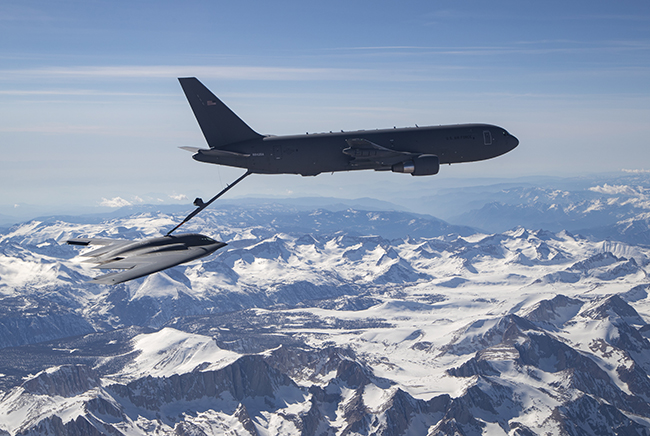
A KC-46 refuels the B-2 for the first time during developmental flight test over Edwards AFB, Calif., and the Sierra Nevada Mountains on Apr. 23, 2019. Air Force photo by Christian Turner.
The Air Force is taking money out of the KC-46 program to keep older KC-135s flying because of delays to the Pegasus program, while some Air Force commanders are hesitant to let their aircraft be refueled by the new tanker—further delaying the schedule, according to a new Government Accountability Office report.
The GAO, in a June 12 report to the House Armed Services seapower and projection forces subcommittee, states that Boeing remains three years behind schedule on the program and plans to deliver the first 18 aircraft with all three refueling subsystems by June 2020. Three “Category One” deficiencies remain: lack of visual clarity in the remote vision system, undetected contacts with receiver aircraft, and boom stiffness while refueling lighter aircraft.
The Air Force is withholding 20 percent of its payments for each aircraft until Boeing meets all contract specifications and corrects the top issues, though the service is covering the $300 million needed to correct boom stiffness. Program officials expect it will take three years to address the most pressing problems. Additionally, there are 160 Category Two deficiencies that the Air Force policy states can be addressed through workarounds, according to the report.
The service wants to complete operational testing by December 2019. However, the schedule is slipping because of these deficiencies and a lack of confidence from some commanders.
“Air Force major commands have been reluctant to allow their receiver aircraft to be tested with the KC-46 over concerns that the lack of visual clarity in the remote vision system and the boom’s stiffness could cause the boom to strike and damage the receiver aircraft,” the report states. “Program officials told us that, as a result, negotiations between the KC-46 program and Air Force major command officials concerning the use of receiver aircraft are taking longer than expected.”
Because of delivery and test delays that are postponing the KC-46’s buildup to full operations, Air Mobility Command in fiscal 2020 plans to reallocate $57 million from the KC-46 program to fly and maintain KC-135s from the 1950s and 1960s longer than planned. At least some KC-135s are expected to continue flying into the 2050s.
“The funding would cover the cost to fly and sustain some KC-135 aircraft above what the command had planned, including the associated personnel costs,” the report states. “Air Mobility Command officials said that decisions about retaining some legacy KC-135 aircraft would be reviewed annually thereafter. If these aircraft are retained, funding would be reallocated from the KC-46 program to support the decision.”
The GAO did note good news in the program. As of January, the Air Force estimates that its total cost for the KC-46, including development, procurement, and military construction, will be $43 billion, about $9 billion less than the 2011 estimate of $51.7 billion.